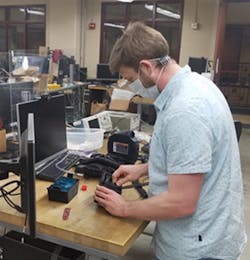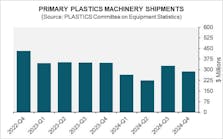By Lynn Manning
In early Spring of 2020, the phone calls and emails started streaming in to the mechanical engineering department of the University of Wisconsin – Madison: “We don’t have enough ventilators, can you design something else?” Then a couple weeks later, “Okay, we have enough ventilators, now we need personal protection equipment (PPE), face shields, and N95 masks.” And suddenly another call for help, “We think we’re going to have to put a powered air-purifying respirator (PAPR) on every person who comes in contact with a Covid-19 patient—we don’t have enough and the ones we have aren’t getting the job done!” The local hospital needed assistance on a variety of fronts.
University of Wisconsin Mechanical Engineering faculty associate Erick Oberstar, and several other instructional staff and tenure-track professors in the U.W. College of Engineering who were allowed to stay on campus after all the students left, felt the pressure. “It was an emotional roller coaster,” he recalls. “There were six or seven of us that literally dropped everything else, and another dozen or so that were contributing. We were all putting in 120 hours a week for two months trying to help out every way we could. The situation was dire. Lives were depending on it.”
A biomedical-engineering Ph.D. candidate, Oberstar is trained in electrical engineering and holds an instructional position in the Department of Mechanical Engineering. Serendipitously, it was his current doctoral research in quantitative blood flow analysis that provided a critical tool for PAPR equipment modifications for the hospital during the pandemic.
Because he did a lot of computed tomography (CT) scanning in a clinical scenario, Oberstar’s department had put him in charge of the Micro-CT machine in its Metrology Lab back in 2014. “That’s when we first found out about Volume Graphics,” he says, but his resources were limited. Later, the department was able to acquire a second, higher-power CT scanner for a sponsored project as well as a research license for Volume Graphics’ VGSTUDIO MAX. This suite of advanced software tools provides digital analysis and visualization of CT scan data, allowing the user to examine a wide variety of material integrity and performance characteristics deep inside an object, non-destructively. “By the time the COVID-19 crisis arose, I’d gotten pretty good at using the tool and knew what it could do,” says Oberstar.
PAPR problems persist
While the first call for ventilators galvanized the engineers into action, as the local hospital’s needs evolved the biggest challenge turned out to be the PAPRs. The hospital had acquired additional ones, but they didn’t have sufficient replacement parts to keep the current stock functioning properly within optimum turnaround times for battery recharging. To complicate matters, their full “fleet” of PAPRs on hand came from four different manufacturers.
A PAPR consists of a fanny pack containing a battery-powered blower that pulls ambient air through a highly efficient filter and sends purified air out a hose that leads up to a helmet. Encased in a sealed, full-body suit, each healthcare provider working with a contagious patient is safe inside a self-contained unit that constantly brings clean air in while keeping viruses out.
PAPRs are very effective, but the batteries that run their blower fans last as few as four hours (although sometimes up to 12 depending on battery model) before requiring a multi-hour recharge—during which time the entire PAPR suit is non-functional. The hospital didn’t have any replacement batteries to switch out for immediate turnaround, and the service life of the filters in their existing blowers was nearing an end—with no replacements available in the supply chain.
“So, we had two issues facing us. One was expired filters and the other was the battery run-time problem,” says Oberstar. “These PAPR devices had to be available for healthcare workers 24/7, which meant we needed to find alternative power sources to use while the original OEM batteries that came with the suits were recharging. We were looking at complicated geometries from a bunch of different PAPR manufacturers and a variety of different battery shapes and filters and we needed to figure out how to get something to plug into all those existing interfaces. It was like an Apollo 13 moment for us. Square peg, round hole.”
An innovative alternative source: power tools
As the engineers began thinking about how to tackle this multifaceted challenge, they realized that an excellent alternative infrastructure for both rechargeable batteries and high-quality air filters could be found in the form of power tool equipment. Yes, those very same battery-operated drills, shop vacs, etc., along with filters like the ones used to keep out dust from concrete and other airborne particulates while operating those tools.
First the filter problem. Industrial filters that the team sourced from local company, Milwaukee Tool, were tested and found to meet National Institute for Occupational Safety and Health (NIOSH) regulations for efficiency. The FDA has issued an Emergency Use Authorization allowing the use of PAPRs in healthcare settings that have been approved by NIOSH as meeting its standards. Modifications to NIOSH-approved PAPRs would likely take them outside the scope of FDA’s EUA, and the FDA and CDC generally advise that hospitals and health care providers use only NIOSH-approved alternatives to N95 respirators whenever feasible. However, the PAPRs modified to use industrial filters meeting NIOSH standards can help fill the gap in health care settings when all other FDA-cleared and NIOSH-approved options have been exhausted.
“An industrial workplace filter uses a HEPA (High-Efficiency Particulate Air) filter just like a hospital device would,” says Oberstar. “We realized that if we scaled industrial filters up to have a greater surface area, they might meet the NIOSH requirements for filter efficiency for the viral particle sizes in question with COVID-19.” After a series of test-runs and redesigns, the team came up with a three-filter design that would fit into the ductwork of the PAPR blower and provide enough surface area to be a viable filter replacement.
The tricky part was getting precision mating geometry for the seals that integrated the redesigned filters into the ductwork so they would be airtight. Many of the parts could easily be 3D printed, but achieving the exact dimensions that would produce the critical, completely sealed filter component was not easy.
This is where CT-data analysis and visualization support from Volume Graphics came into play. Using the multi-material capabilities in the software, Volume Graphics Customer Support Coordinator Kamil Szepanski used images recreated with data from the University’s CT equipment to segment out the individual geometries of the rubber gaskets, filter material and plastic resin. By analyzing the different densities of each material and providing metrics that could be used to guide the redesign and integration of the mating surfaces between the different entities, the software provided valuable support for the product-development process.
The digital tools also helped with the battery challenge. The engineers were able to find over-the-counter power-tool batteries that had adaptors that would step them down from 18 volts to the 12 volts the PAPR blower needed. But the adaptors didn’t match the existing PAPRs’ geometry. The team CT-scanned each type of adapter, used VGSTUDIO MAX to segment out the geometries of its plastic cover, and designed custom connectors that could be integrated into the PAPR assembly.
“We also did medium-energy CT scans of the actual batteries so that we could obtain the mating geometry and the terminal contact locations,” says Oberstar. “This enabled us to align the batteries with the mechanical interface of the PAPR.”
“Crisis reverse-engineering”
During the pandemic shutdown, Volume Graphics’ Szepanski worked remotely with the University of Wisconsin team for many weeks. “They were essentially CT-scanning all the mating surfaces involved and then we assisted in using the scan data to reverse engineer them,” he says.
“Only with CT can one capture all the parts within an object in one take and then differentiate between the variety of materials they are made up of. Using VGSTUDIO MAX’s segmentation capabilities and multi-material surface determination, it was a fast process to derive these geometries and export them as a mesh that was then used for the reverse engineering process.”
A particularly difficult task Szepanski remembers was that the internal snap-and-lock mechanism on the battery cover needed to be precisely replicated so the adaptor wouldn’t fall out. “That was challenging because the battery housing had a really complicated structure with so many contact zones,” he recalls.
Oberstar knew the importance of the insights that analyzing CT-scan data wasproviding his team. “The power of everything we did with this analysis and visualization software was that
we were able to generate volumetric data on a huge variety of different objects, some of which were plastic, others metal, and extract out the critical mating surfaces for both filters and batteries and then take that geometry from VGSTUDIO MAX back into our CAD system and then on to 3D printing,” he says.
“We were definitely reverse engineering our way through a crisis. None of what we’ve been able to accomplish would’ve been possible in a vacuum. There were numerous steps along the way, VGSTUDIO MAX being one important solution along with the countless efforts of other engineers in the College of Engineering. We’d be at a point where it would seem that what we were trying to do was impossible—and then someone else would step up and say, ‘Oh, I can get that done.’ All that teamwork helped us make a real difference.”
The teamwork continues. The hospital is using a face-shield design, that has now gone global, created by the University’s Grainger Engineering Design Innovation Laboratory, in the College of Engineering. Another engineering team is using Volume Graphics software to analyze fiber orientation in composite materials. Meanwhile, Oberstar continues to refine his PAPR-filter parameters. And he’s now using Volume Graphics’ software in a component reverse-engineering project that’s part of his Ph.D. work, modifying the design of a large linear actuator used for truck lift gates into equipment that injects iodine contrast into patients to image their blood vessels.
“It’s clear that I really love engineering,” he happily acknowledges…and, most importantly, he and the others at the University of Wisconsin College of Engineering are pleased to be doing everything they can to help the world through the pandemic.
December 2020 update: The University of Wisconsin was going into a preproduction clinical trial with the hospital on the replacement battery system. While the work described in this case study involved a single battery, due to increased PAPR battery demand research work shifted to focus on a dual-battery approach towards the end of the year. Next the plan was to proceed to clinical evaluation of the efficiency of the filter system.










